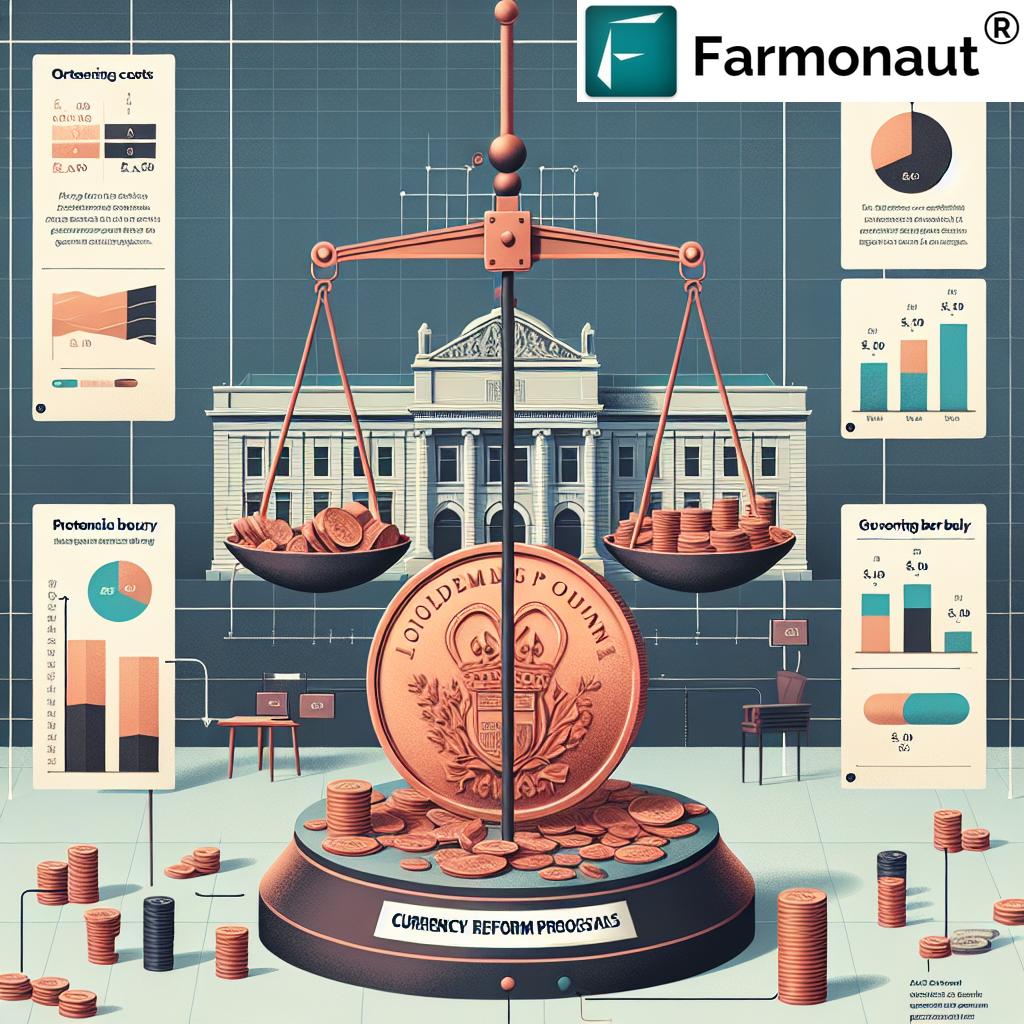Treasury Department Halts Penny Production: Analyzing the Cost and Efficiency Debate in Washington
“The U.S. Mint loses 1.7 cents on every penny produced, with each coin costing 3.7 cents to manufacture.”
In a groundbreaking move that has sent ripples through the United States’ financial landscape, the Treasury Department faces a potential halt in penny production due to rising costs and efficiency concerns. This decision, part of broader government initiatives, highlights the ongoing debate about penny minting and its impact on the U.S. Mint’s finances. As we delve into this complex issue, we’ll explore the implications of discontinuing the penny, including potential savings, streamlined transactions, and historical precedents.
The Penny Production Dilemma
At the heart of this controversy lies a simple yet startling fact: each penny costs more to produce than its face value. With production costs soaring to 3.7 cents per penny, the U.S. Mint has been operating at a loss for years when it comes to this ubiquitous coin. This financial inefficiency has led to significant losses for the Mint, prompting a re-evaluation of the penny’s role in our currency system.

The decision to potentially halt penny production is not made in isolation. It’s part of a broader initiative aimed at improving government efficiency and reducing unnecessary expenditures. The Department of Government Efficiency, under the leadership of Elon Musk, has been instrumental in highlighting the financial impracticalities of penny production.
The Numbers Behind the Decision
To fully grasp the magnitude of this issue, let’s look at some key figures:
- In the fiscal year ending September 2024, the U.S. Mint produced approximately 3.2 billion pennies.
- This production resulted in a loss of about $85.3 million for the Mint.
- The cost of producing a penny has increased from 3.1 cents to 3.7 cents in just one year.
These numbers paint a clear picture of the financial strain that penny production places on the U.S. Mint and, by extension, on taxpayers.
The Political Landscape
The move to halt penny production has sparked a heated debate in Washington. While the Treasury Department is pushing for this change, the ultimate decision may require Congressional approval. Currency specifications, including the minting and metal composition of coins, traditionally fall under the jurisdiction of Congress.
However, some economists, including Robert K. Triest from Northeastern University, suggest there might be some flexibility. The Secretary of the Treasury might feasibly halt the minting of new pennies without explicit legislative action, though this would likely be a temporary measure at best.
Historical Context and International Precedents
The United States has a history of phasing out low-value currency when it becomes impractical. In 1857, the half-cent coin was discontinued, setting a precedent for eliminating coins that no longer serve a practical economic purpose. More recently, other countries have taken similar steps:
- Canada stopped minting pennies in 2012
- Several European countries phased out their lowest-denomination coins after adopting the euro
- Australia and New Zealand have also eliminated their one and two-cent coins
These international examples provide valuable insights into the potential impacts of discontinuing the penny in the United States.
The Cost-Benefit Analysis
Advocates for eliminating the penny argue that doing so would result in considerable cost savings and streamline transactions at cash registers. Let’s break down the potential benefits:
- Cost Savings: Eliminating penny production could save the U.S. Treasury millions of dollars annually.
- Transaction Efficiency: Rounding prices to the nearest five cents could speed up cash transactions.
- Environmental Impact: Reducing metal mining and coin production could have positive environmental effects.
- Resource Reallocation: The Mint could focus on producing more valuable coins and currency.
“Discontinuing penny production could potentially save the U.S. Treasury millions annually, impacting government efficiency efforts.”
The Role of Technology in Modern Currency
As we discuss the future of the penny, it’s important to consider the evolving role of technology in our financial systems. Digital payments and cryptocurrencies are becoming increasingly prevalent, potentially reducing the need for physical currency in some transactions.
At Farmonaut, we understand the importance of staying ahead of technological trends. While our focus is on agricultural technology, we recognize the parallels between modernizing currency and revolutionizing farming practices. Just as the Treasury Department is reevaluating traditional currency, we’re helping farmers embrace cutting-edge technologies to improve efficiency and productivity.
Our satellite-based farm management solutions offer real-time insights that can help farmers make data-driven decisions, much like how modern financial systems are evolving to meet the needs of a digital economy.
The Impact on Businesses and Consumers
If the penny is discontinued, businesses and consumers will need to adapt. Here are some potential changes:
- Cash transactions would be rounded to the nearest nickel
- Electronic transactions could still be calculated to the cent
- Businesses might need to update their point-of-sale systems
- Consumers may see slight changes in their purchasing power for cash transactions
While these changes might seem significant, many economists argue that the overall impact on inflation and consumer spending would be minimal.
The Debate in Congress
Over the years, various members of Congress have attempted to legislate the discontinuation of the penny through multiple proposals. These efforts have included:
- Bills to suspend penny production
- Proposals to eliminate the penny from circulation
- Suggestions to round prices to the nearest five cents
While none of these proposals have succeeded so far, the current economic climate and the Treasury Department’s stance may provide the momentum needed for change.
Public Opinion and Cultural Significance
The penny holds a special place in American culture, from the common phrase “a penny for your thoughts” to the luck associated with finding a penny on the ground. Public opinion on eliminating the penny is divided, with some arguing for tradition and others prioritizing practicality.
A comprehensive public education campaign would be crucial if the decision to discontinue the penny moves forward. This would help citizens understand the reasoning behind the change and how it would affect their daily lives.
Explore Farmonaut’s API for advanced agricultural data analysis
Environmental Considerations
The environmental impact of penny production is another factor to consider. The mining and processing of metals used in coin production have significant environmental costs. By discontinuing the penny, we could potentially reduce:
- Energy consumption in metal extraction and coin minting
- Carbon emissions associated with coin production and distribution
- The need for harmful chemicals used in the metal refining process
These environmental benefits align with broader sustainability goals and could be a compelling argument for those concerned about the ecological footprint of our currency system.

The Future of U.S. Currency
The debate over the penny is part of a larger conversation about the future of U.S. currency. As we move towards a more digital economy, questions arise about the role of physical currency in general. Some points to consider:
- The potential for a digital dollar issued by the Federal Reserve
- The increasing prevalence of contactless and mobile payments
- The need for a currency system that balances tradition with modern economic realities
These considerations will shape not only the fate of the penny but also the broader landscape of U.S. monetary policy.
Check out our API Developer Docs for integration possibilities
Economic Implications
The economic implications of discontinuing the penny extend beyond the immediate cost savings. Economists are debating potential effects on:
- Inflation rates
- Consumer spending patterns
- The velocity of money in the economy
- The overall efficiency of the U.S. monetary system
While some fear that rounding prices could lead to slight inflationary pressures, others argue that the effect would be negligible and offset by increased transaction efficiency.
Technological Solutions in Currency and Agriculture
As we contemplate the future of U.S. currency, it’s worth noting the parallel advancements in other sectors, such as agriculture. At Farmonaut, we’re at the forefront of integrating technology into traditional farming practices. Our satellite-based crop health monitoring and AI-driven advisory systems represent the kind of innovative thinking that could also benefit the currency sector.
Just as we use advanced technologies to help farmers make data-driven decisions, similar approaches could be applied to modernize our currency system, making it more efficient and responsive to economic needs.
The Role of Government Efficiency
The potential discontinuation of the penny is part of a broader push for government efficiency. This initiative, spearheaded by the Department of Government Efficiency under Elon Musk’s leadership, aims to streamline operations and reduce wasteful spending across federal agencies.
Key aspects of this efficiency drive include:
- Identifying and eliminating redundant processes
- Leveraging technology to automate routine tasks
- Reevaluating long-standing practices that may no longer be cost-effective
- Encouraging innovation in government operations
The penny debate exemplifies how even small changes can have significant impacts on government spending and efficiency.
International Trade Considerations
While the penny may seem like a domestic issue, changes to U.S. currency can have international implications. Considerations include:
- The impact on foreign exchange markets
- How international businesses operating in the U.S. might adapt
- Potential changes to trade agreements that reference specific currency denominations
These factors underscore the complexity of making changes to a currency as globally significant as the U.S. dollar.
The Future of Coin Production
If the penny is discontinued, it could lead to a reevaluation of other coin denominations. Questions to consider include:
- Should the nickel also be phased out, given its production costs?
- Is there a need for new coin denominations to fill the gap?
- How might the composition of remaining coins be altered to reduce production costs?
These questions highlight the ongoing need to balance tradition with economic practicality in our currency system.
Comparative Analysis: U.S. Coin Production Costs
| Coin Denomination | Face Value | Production Cost (est.) | Cost-to-Value Ratio | Annual Production Volume (est.) | Annual Loss/Profit (est.) |
|---|---|---|---|---|---|
| Penny | $0.01 | $0.037 | 370% | 3.2 billion | -$85.3 million |
| Nickel | $0.05 | $0.14 | 280% | 1.2 billion | -$108 million |
| Dime | $0.10 | $0.08 | 80% | 2.1 billion | +$42 million |
| Quarter | $0.25 | $0.18 | 72% | 1.8 billion | +$126 million |
This table clearly illustrates the financial inefficiency of penny and nickel production compared to other coins. It provides a comprehensive overview of the cost issues facing the U.S. Mint, supporting the Treasury Department’s decision to reconsider penny production.
Technological Innovation in Currency and Agriculture
As we discuss the future of U.S. currency, it’s worth noting the parallel advancements in other sectors, such as agriculture. At Farmonaut, we’re at the forefront of integrating technology into traditional farming practices. Our satellite-based crop health monitoring and AI-driven advisory systems represent the kind of innovative thinking that could also benefit the currency sector.
Earn With Farmonaut: Earn 20% recurring commission with Farmonaut’s affiliate program by sharing your promo code and helping farmers save 10%. Onboard 10 Elite farmers monthly to earn a minimum of $148,000 annually—start now and grow your income!
Conclusion: A Penny for Your Thoughts?
As we’ve explored in this comprehensive analysis, the debate over discontinuing penny production is multifaceted and complex. It touches on issues of economic efficiency, government spending, cultural tradition, and technological advancement. While the financial arguments for eliminating the penny are compelling, the decision must also consider broader impacts on society and the economy.
As this debate continues in Washington, it’s clear that any decision will have far-reaching implications. Whether the penny remains a part of our currency or becomes a relic of the past, this discussion highlights the ongoing need to adapt our financial systems to changing economic realities.
At Farmonaut, we understand the importance of adapting to change and embracing innovation. While our focus is on revolutionizing agriculture through technology, we recognize the parallels between modernizing farming practices and evolving currency systems. Both require a willingness to challenge traditional methods in pursuit of greater efficiency and sustainability.
FAQ Section
- Q: Why does it cost more to produce a penny than its face value?
A: The cost of metal and labor required to produce a penny exceeds its face value due to rising material and production costs. - Q: How much money could be saved by discontinuing the penny?
A: The U.S. Treasury could potentially save millions of dollars annually by eliminating penny production. - Q: Would discontinuing the penny lead to inflation?
A: Most economists believe the impact on inflation would be minimal, as electronic transactions would still be calculated to the cent. - Q: How would cash transactions work without pennies?
A: Cash transactions would likely be rounded to the nearest nickel, similar to systems implemented in other countries that have eliminated low-value coins. - Q: What would happen to existing pennies if production is halted?
A: Existing pennies would likely remain in circulation until naturally phased out over time.
As we continue to monitor the developments in Washington regarding the future of the penny, we at Farmonaut remain committed to driving innovation in our field. Just as the Treasury Department is considering ways to modernize currency, we’re constantly exploring new technologies to make agriculture more efficient and sustainable.
We invite you to explore how Farmonaut’s cutting-edge solutions can revolutionize your farming practices. Whether you’re looking to optimize crop yields, reduce resource usage, or make data-driven decisions, our platform offers the tools you need to succeed in modern agriculture.
Join us in embracing the future of farming, where innovation meets tradition to create more sustainable and productive agricultural practices.
















